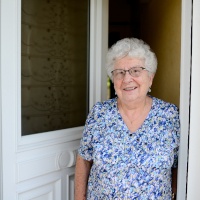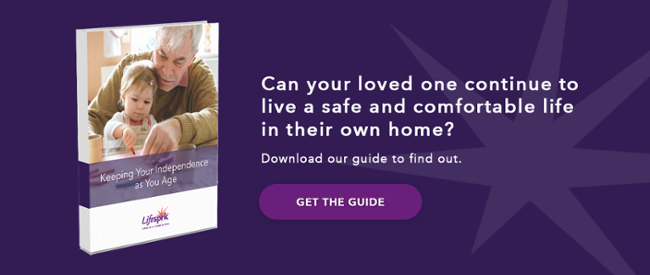
A senior’s fall can be caused by many factors, they may have a disease which impedes their mobility, a decrease in their activity levels that has weakened their muscles, or declining cognitive ability that has brought on impaired balance or vision. Sometimes a fall simply happens because a senior cannot do everyday tasks in the way that they used to.
“When a fall has occurred, there are ways to help seniors remain in their homes safely,” said Vicki Condon, RN, Lifesprk RN Case Manager. “It starts with rebuilding their confidence. The fear of falling again plays a role in how someone heals afterwards. It’s that fear that limits their activities and can slow down rehab which can spiral further physical decline and increase social isolation.”
A fall can be a serious setback for your loved one and could impair their mobility. Some falls can even put seniors into life-threatening situations or give them serious injuries. There are ways to proactively address safety and fall risks to prevent and decrease falls.
Here are some simple tips to make your loved one’s home more safe:
Grab bars
Installing grab bars around the house is a great way to give your loved one extra support when moving from room-to-room. Your loved one may be struggling to get out of their chair, bed, or moving freely around the house. Grab bars can offer a simple solution that enables them to maintain their independence and give them confidence while moving around the house.
Automatic lifts
If your loved one is having difficulty going up and down the stairs or getting out of bed, a lift can support their ability to manage getting around their house on their own.
Chair lifts for both the stairs and beds can be a good way of minimizing risk for your loved one if they want to stay in their current home and need a little bit of extra support.
Lighting
Make sure all rooms are well lit and there are light switches located at every entry. Try adding more light fixtures or nightlights throughout the house to ensure your loved one can navigate the space and avoid any potential hazards. Darkness can make it difficult to see where you are stepping, items on the floor, and edges of furniture that can become potential tripping hazards.
Clean the house
It’s possible that your loved one has lived in the same home for decades and it may not have had a deep clean in a long time. Clutter can be hazardous and block otherwise clear pathways resulting in obstacles that can cause falls. Spend a weekend giving your loved one a hand around the house to see if you can reduce the amount of clutter and objects in their home or hire a service to come in and take care of some of the cleaning. The goal is to eliminate anything obstructing their mobility throughout the house.
Tripping/slipping hazards
Be aware of everyday hazards throughout the home that might be difficult for your loved one to avoid. There shouldn’t be any electric cables, shoes, or moveable rugs. All of these items have the potential to cause falls or make your loved one trip.
Seniors who have impaired mobility probably won’t be able to avoid these tricky obstacles and tripping hazards. It’s always best to be extra cautious and remove anything that you think could cause a potential fall.
Stairway safety
Stairs are a major culprit of falls. Make sure that the staircases in your loved one’s home have sturdy, easy-to-grab handrails that extend the full length of the stairs. Remember to put in handrails next to other stairs in the home, even if it is just one stair. Also, ensure that stairs are clearly lit and that there aren’t any loose steps.
Bathroom
The bathroom is a small space that can contain many slipping and tripping hazards. Putting in handrails next to the bath and toilet can help eliminate some of the risks of falling when bathing and toileting. Make sure floors are not slippery and there are rugs to absorb water as they can become a serious hazard when wet. Also, make sure that baths and showers have a non-slip surface.
How a Lifesprk Nurse can make your loved one’s home more safe
Our nurses can visit your loved one’s home regularly and check that the house is free of potential fall risks. Caring for seniors is often a combined team effort between their children and in-home provider team. Tap into the expertise and experience of a Lifesprk nurse who can work out a plan for keeping your loved one independent and living in their homes for as long as possible. Once your nurse is familiar with your loved one’s home, they will be able to give you plenty of advice on keeping your loved one’s home safe.




